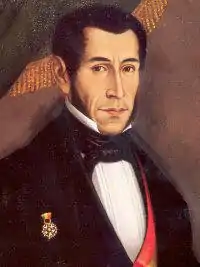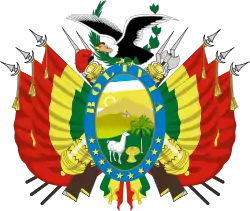Mariano Enrique Calvo
Mariano Enrique Calvo Cuellar (18 July 1782 – 29 July 1842) was a Bolivian lawyer and politician who served as the de facto 8th President of Bolivia briefly in 1841. He also served as the 3rd Vice President from 1835 to 1839 during which he also held the powers of acting president while President Andrés de Santa Cruz was in Peru.
Mariano Enrique Calvo Cuellar | |
|---|---|
 | |
| 8th President of Bolivia | |
| In office 9 July 1841 – 22 September 1841 | |
| Preceded by | Sebastián Ágreda |
| Succeeded by | José Ballivián |
| 3rd Vice President of Bolivia | |
| In office 23 July 1835 – 17 February 1839 | |
| President | Andrés de Santa Cruz |
| Preceded by | José Miguel de Velasco |
| Succeeded by | Aniceto Arce Belisario Salinas |
| Foreign Minister of Bolivia | |
| In office 25 January 1833 – 16 August 1835 | |
| President | Andrés de Santa Cruz |
| Preceded by | Casimiro Olañeta |
| Succeeded by | José Ignacio de Sanjinés |
| In office 3 July 1829 – 16 August 1831 | |
| President | Andrés de Santa Cruz |
| Preceded by | José María de Lara |
| Succeeded by | Manuel José de Asin Franco |
| Personal details | |
| Born | 18 July 1782 Sucre, Bolivia |
| Died | 29 July 1842 (aged 60) Cochabamba, Bolivia |
| Nationality | Bolivian |
Biography
Educated as a Chuquisaca lawyer, Calvo had been a royalist who was even head of the Cabildo (colonial assembly) in 1818. He later switched sides and, despite spending a number of years in the political wilderness, distinguished himself in the 1830s as a supporter, collaborator, and cabinet member of Andrés de Santa Cruz, rising to the post of Minister of Foreign Relations. He then became Vice-President of the Bolivian portion of the Peru-Bolivian Confederation, again under Santa Cruz, who was both President of Bolivia and the Confederation's Supreme Protector in Lima. As such, most of the daily running of affairs in Bolivia fell to the trusted Calvo.
With Sebastián Ágreda's resignation in 1841, Congress was reassembled. The latter desperately wanted to return to established Constitutional norms, and thus agreed to temporarily turn the reins of state to Calvo, as the last Vice-President of Bolivia under Santa Cruz, pending the latter's return. Calvo is thus considered to be the first civilian President of Bolivia. He had difficulty, however, in running the country, with the military divided among pro-Velasco and pro-Santa Cruz camps. In fact, civil war loomed, with part of the country under different military controls, and with a pending Peruvian invasion known to be on its way at the worst of times.
The latter finally materialized (no doubt spurred by the unmistakable appearance of chaos and weakness at the helm in La Paz) in late August 1841. Trusting the fate of the whole country to its military, Calvo could only hope for a miracle. The latter indeed occurred, when General José Ballivián, head of the Bolivian Army, inflicted an astonishing defeat on the invading forces of Peru at the Battle of Ingavi, where the Peruvian President himself, the notorious Agustin Gamarra, was made prisoner and later executed by Ballivián. With the latter the indisputable hero of the moment, Calvo could only acquiesce when Congress named the General Provisional President, once again pending a possible return of Marshall Santa Cruz. Calvo would die only a year later in Cochabamba. He was the first native of the Bolivian capital, La Plata/Chuquisaca (later renamed Sucre) to occupy the Bolivian presidency, and also has the distinction of having been President at the time of the rout of Peruvian forces at Ingavi.
References
| Political offices | ||
|---|---|---|
| Preceded by José María de Lara |
Foreign Minister of Bolivia 1829–1831 |
Succeeded by Manuel José de Asin Franco |
| Preceded by Casimiro Olañeta |
Foreign Minister of Bolivia 1833–1835 |
Succeeded by José Ignacio de Sanjinés |
| Preceded by José Miguel de Velasco Franco |
Vice President of Bolivia 1835–1839 |
Succeeded by Aniceto Arce Belisario Salinas |
| Preceded by Sebastián Ágreda |
President of Bolivia 1841 |
Succeeded by José Ballivián Segurola |
